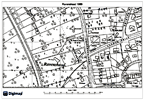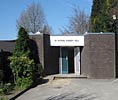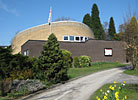For this church:    |
|
 Ravenshead in 1969
Ravenshead in 1969© Crown Copyright and |
 Interior of the Interior of thechurch hall |
In August 1943 the Rev Walter Warr, the vicar of St Mary of the Purification, Blidworth (1940-1956), held a meeting to discuss the purchase of the current church site which was later acquired at a price of £600. This enabled the first church to be built which was a sectional building purchased from the Ministry of Works in November 1946, and erected by its founder members. The church was named St Peter’s, then within a hamlet known as Larch Farm, and was dedicated by Dr F.R. Barry, Bishop of Southwell on 29 June 1948.
The building served the growing village with the dual purpose of worship and social life. Bishop Barry hoped it would be a ‘missionary depot building up a vital Christian community standing for everything good in the lives of men and women of the area’.
Planning consent for a future church building on the present site was given by Nottinghamshire County Council in 1956. The three former hamlets amalgamated and became Ravenshead village in 1966. Detailed planning permission was given for the erection of the newly designed church in 1969.
The new church foundation was laid in February 1971 and by May 1971 the church had been renamed St Peter’s Church, Ravenshead. The village became an ecclesiastical parish in its own right in November 1971 and following construction, the building was dedicated on 22nd April 1972 by the Right Reverend Denis Wakeling, Bishop of Southwell. The Vicar, the Reverend Barrie Hodges, stated at the dedication ceremony ‘The purposes that have led to it being this shape have been our concern to create a setting and the facilities for the contemporary liturgical and educational activities of the Church, and the desire to have social space close at hand for the use of the congregation around service time.’
 The original church building became the church hall and was refurbished in 1975 with a new brick front elevation, linking the hall and the church with a walkway formed between the church and the hall at the rear. The hall was also enlarged with a cloakroom, kitchen and toilets added. In addition, a car park was laid to the road frontage serving the church and the hall. Prior to this the church was approached over open rough ground.
The original church building became the church hall and was refurbished in 1975 with a new brick front elevation, linking the hall and the church with a walkway formed between the church and the hall at the rear. The hall was also enlarged with a cloakroom, kitchen and toilets added. In addition, a car park was laid to the road frontage serving the church and the hall. Prior to this the church was approached over open rough ground.
For many years the church logo indicated a picture of the church behind a group of silver birch trees; regrettably, these trees were deemed to be unsafe in 1996 and an order was issued to fell them by the local council. New yew trees have since been planted, together with other trees to the rear of the church.
The church hall was demolished in 2014 and replaced with a community centre ('The Centre') that officially opened in May 2015.






